Another journey of culinary delights was a recent trip where I spent two weeks traveling in Vietnam learning about the foods and culture. Here is the first article I put together on my Food Travels – Eating Around Vietnam beginning in Hanoi.
I signed on for a trip to Vietnam with You Go Girls, a tour company based out of Portland, Oregon. The owner, Marcia Miller, and I met at Costco and hit it off immediately. We chatted for a while about our jobs and hobbies and then exchanged cards.
Flash forward to a year later. I was looking for a new travel destination when I remembered Marcia. I went to the internet to find her travel company, You Go Girls. On the website there was a menu of tours to choose from for destinations all over the world. I chose Vietnam because It was the next available tour; and I have always wanted to go to there. It all just fell into place to be my next destination.
If you haven’t travelled with a tour group before, you should know there are some pros and cons. I have only been on one other tour before, and it was a much smaller group where I knew everyone I was traveling with. Vietnam would be the first time that I would travel with a large group of total strangers. I was also going to share a room with someone I had not met yet as I didn’t have a travel mate. Paying for the single rate is much more expensive the traveling as a couple.
Tours are great because you don’t have to plan anything, and tours can be annoying because you don’t get to plan anything. Many pros and cons about travelling with a tour are one in the same. If you are like me, I am the one in my family that does all the planning, so it is nice to go somewhere when someone else has done all the work. The other thing to consider is that you may not have chemistry with everyone in your group. On the flip side, there are going to be some people who you become fast friends with and end up spending the majority of your journey with them. I met several great people on my trip to Vietnam that I would travel with again in an instant.
Another consideration, sometimes you just get tired, as the pace of a tour is pretty much go all the time and you don’t want to miss anything. Next time I will take time to slow down a bit and enjoy some of the places that resonated with me. I’ll skip a sight or two in a city and add relaxation into my agenda.
Getting Ready to Travel to Vietnam
I quickly discovered that a big part of going to Vietnam is getting ready to go. I had to apply for a Visa, as well as getting vaccinations and a prescription for emergency antibiotics, just in case I encountered some bad food along the way. I had to find the right mosquito repellant and find clothing that wouldn’t attract mosquitoes. We would also be travelling between the north and the south with varying climates.
When travelling to Vietnam, be sure to talk to a doctor or nurse about your itinerary and discuss where you will be on your journey and what time of year you will be travelling. They will be your first line of knowledge and will recommend which immunizations you need. I found a travel clinic nearby my home and made an appointment for my Hep A, Tetanus, Diphtheria and Typhoid shots. I also had a flu shot a few weeks later.
Another precaution that the travel nurse shared with me was the advice to start taking probiotics as they help maintain a healthy level of digestive bacteria. Starting a regimen of probiotics several weeks before the trip to Vietnam would help build “friendly” bacteria that can compete against “unfriendly” bacteria. According to the National Institute of Health, probiotics can make your body’s shield against germs tougher and kick your immune cells into a higher gear when they’re working to protect you against invaders. You want to use a probiotic with at least 30 billion CFU. I ordered the probiotics directly from Amazon.
What’s Cooking for Breakfast In Vietnam?
When I travel my main goal is to learn and partake in the culinary landscape of a place. What I have discovered in my travels so far is that two of the most interesting differences around the world are how people take their breakfast and drink their coffee.
Breakfast Culture
Breakfast options seem to vary widely from place to place. The first breakfast that I ate in Vietnam was at the hotel in Hanoi. The food choices included many American breakfast favorites and several Vietnamese options, including Pho.
In Vietnam, Pho for breakfast is not only common but actually a very practical meal. It’s warm, hearty, has protein and isn’t too heavy. A small bowl of Pho is a really great way to start the day. In the U.S. when we dine at a Vietnamese restaurant, we order Pho for dinner and the size of the bowl is huge in comparison to the portion you eat for breakfast in Vietnam.
Pho is the most popular breakfast dish in Vietnam. You will find so many places to eat Pho and they all have different flavors. The best part about Pho is that each broth recipe is unique, and the recipe is secret to the place you are eating it at. Of course, you will find the basic ingredients that make up the Pho broth which include stewing bones. Bones could be from beef, pork, or chicken and any combination of the three. The other basic ingredient “gao te” known as the rice noodle. The real secret of Pho lies in the combination of spices that are expertly blended to make that hearty morning bowl of energy to start the day.
Have You Tried Vietnamese Coffee “Ca phe”?
Coffee Culture
Another passion of mine while travelling is discovering coffee culture. Although I don’t drink coffee at home, I can’t help but to partake of coffee while travelling. I find myself wanting to know everything about coffee in other countries, so I have to drink it. Coffee is another tradition that is very specific to the region you are in. When you travel discovering how the locals take their coffee is always a treat.
A bit of coffee history, Vietnam was once a French colony and it was the French that introduced coffee to the Vietnamese with Robusta coffee. Today, Vietnam is the number one exporter of Robusta. It didn’t take long for the Vietnamese to embrace coffee fully and adopt their own practices and rituals around coffee, the morning cup of joe.
The Classic Vietnamese Drip
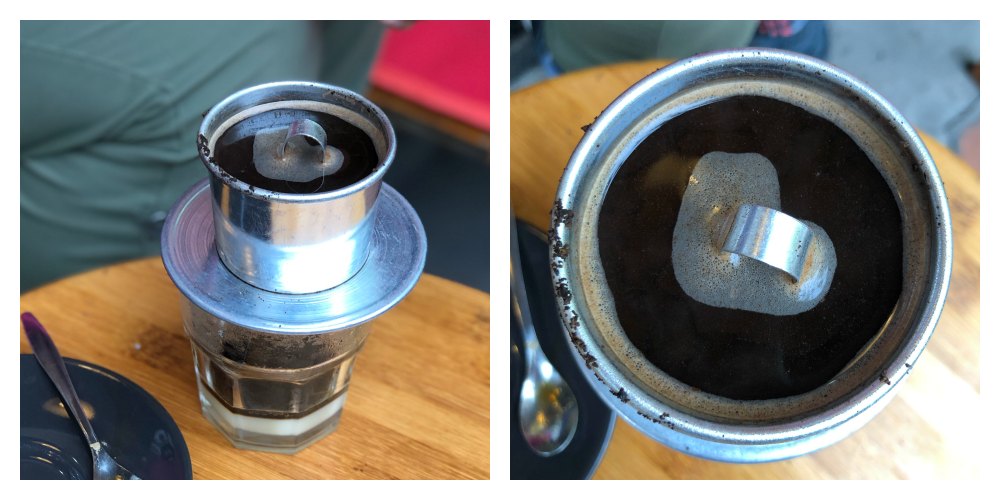
Everywhere you go from street corners, retail store to coffee shops, you will find people congregating over coffee. Each with their own cup and personal metal coffee filter called a phin. The phin perches on top of the cup and finely ground coffee is added. A metal screen is tightened down on the grounds by screwing it down with a few spins until snug. A small amount of hot water is slowly poured over the screen and left to sit a few minutes while the grounds “bloom”. Absorbing the hot water, the grounds fill in the cracks and gaps making a stronger barrier. The rest of the water slowly filters its way through, gathering as much flavor as possible before slowly dripping into your cup. It is a treat worth waiting for, a very rich dark and bitter coffee that can be quite addicting to make as well as to drink. Coffee in Vietnam is not a grab and go affair, but an opportunity to sit down with friends and chat while you patiently wait for the cup to fill.
The straight black coffee is strong, that is why sweetened condensed milk is often added to the cup before the drip process. The conflicting notes of bitter and sweet tastes really delicious and solidify your love of Vietnamese coffee. In north Vietnam this is called ca phe na, in south Vietnam it’s called ca phe sua. Either way it is delicious, strong and addicting.
Egg Coffee, “ca phe trung”at Giang Café
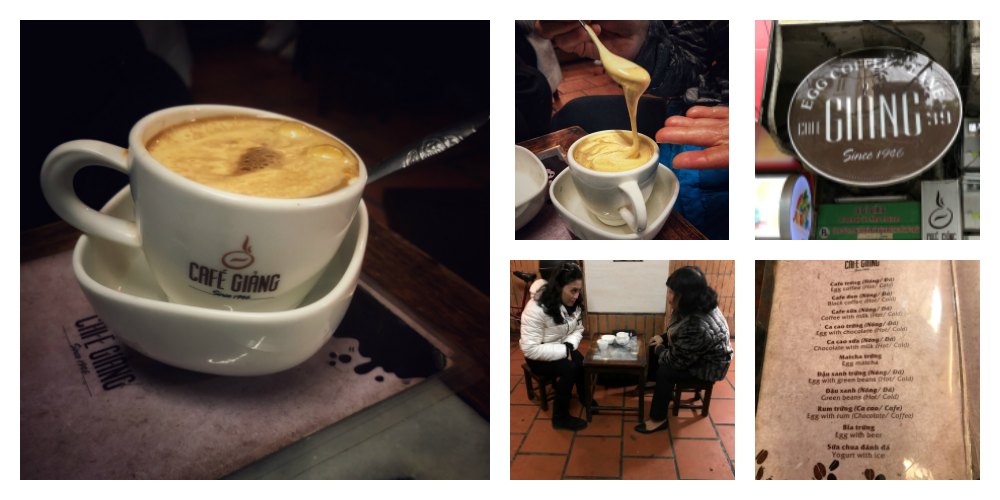
Another must visit place in Hanoi, Giang Café. Giang Café is another sample of coffee culture you must try. Famous for Egg Coffee, “ca phe trung”. I know, I took pause too, wondering what egg coffee was. Was it a fried egg in coffee? A hardboiled egg stewed in coffee? Many thoughts came to my mind so I was excited to go to the Café where they serve the ORIGINAL Egg Coffee, “ca phe trung”.
It’s easy to miss, located on Nguyen Huu Huan Street in the city’s old quarter, look for a long alley between two shops that leads you into the two-story café. Here as with everywhere in Vietnam, there were small tables and chairs where loyal patrons have been sipping coffee for years. According to Mr Giang’s son, Mr Nguyen Tri Hoa, the ingredients of Egg Coffee, “ca phe trung” include, “chicken egg yolk, Vietnamese coffee powder, sweetened condensed milk, butter and cheese. The coffee is brewed in a small cup with a filter before the addition of a well-whisked mixture of the yolk and other ingredients. The cup is placed in a bowl of hot water to keep its temperature.”
Many other coffee shops have tried to duplicate the recipe but can’t seem to find the right blend and measure of ingredients to accomplish the same taste that Mr. Giang developed over 70 years ago.
My first sip of this coffee concoction was sweet and creamy, strong and bitter all in one mouthful. The delicious blend was WOW! You’re awake, and “Good Morning Vietnam!” It makes a great breakfast coffee because of the protein of the egg and a great desert coffee because of the sweet creamy tiramisu flavor.
The story of Egg Coffee, “ca phe trung” began back in 1946, in Hanoi. During this time there was a milk shortage and the inventive bartender Mr. Nguyen Giang, decided that blending the egg yolk with sugar would be an acceptable substitute for milk. Mr. Giang was working at the Metropole Hotel as a bartender at the time and he began serving his egg coffee to hotel guests, and it quickly caught on as a delicacy. He then opened his own coffee shop serving up his Vietnamese egg coffee. Today it is a family run coffee shop located at 39 Nguyen Huu Huan. It is the only place to have an ORIGINAL Vietnamese egg coffee and should be on your list of the best things to do in Hanoi.
Foods to try in Vietnam
There are many great dishes, and ingredients in Vietnam that Haven’t been able to find back at home so don’t miss some of these while traveling in Vietnam. It is always fun to find and try new foods and some of my favorites included;
The Welcome Drink

A tradition that I loved in Vietnam was the welcome drink. As a guest in a home, hotel, restaurant and various other establishments, you were welcomed with a refreshing Welcome Drink, cold in the summer and hot in winter. Welcome drinks are often made of tea or juices and various other little tidbits to make a refreshing and relaxing arrival beverage. We had drinks that used cucumber, cinnamon, ginger, sprouted basil seeds, lemon grass, all blended in a light appealing taste. I am now working on developing my own welcome drink for my guests at home.
Tonkin Jasmine known as“bông thiên lý”, “hoa thiên lý” or “dạ lý hương”.
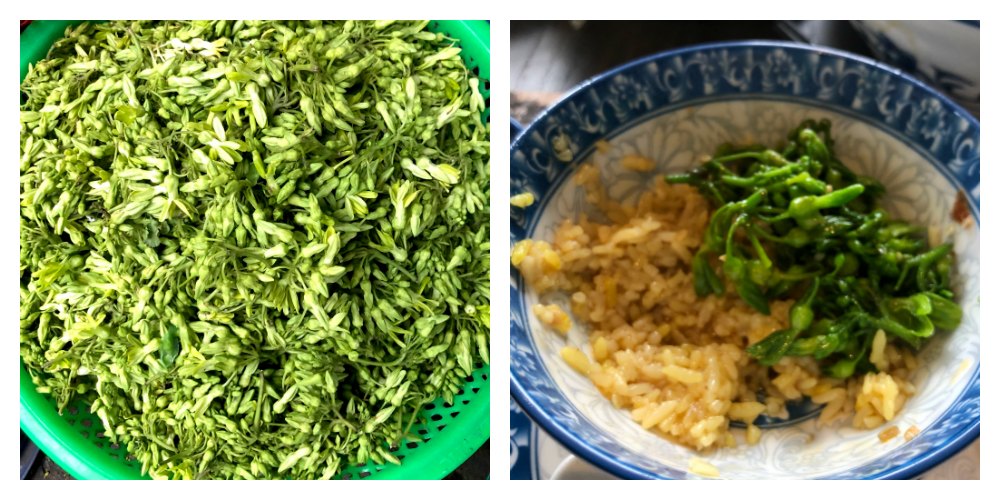
They are night-blooming flowers that can be found all around Vietnam. They have a scent similar to Ylang Ylang flowers. Tonkin jasmine is commonly used in traditional medicine and used as a common vegetable side for a meal and/or an ingredient in a recipe. When cooked, the flowers turn bright green and have a fabulous crunchy texture with a very slight aromatic flavor. It became my favorite side dish for most my meals while in Vietnam. I couldn’t get enough of it.
Banana Blossoms (Hoa chuối)
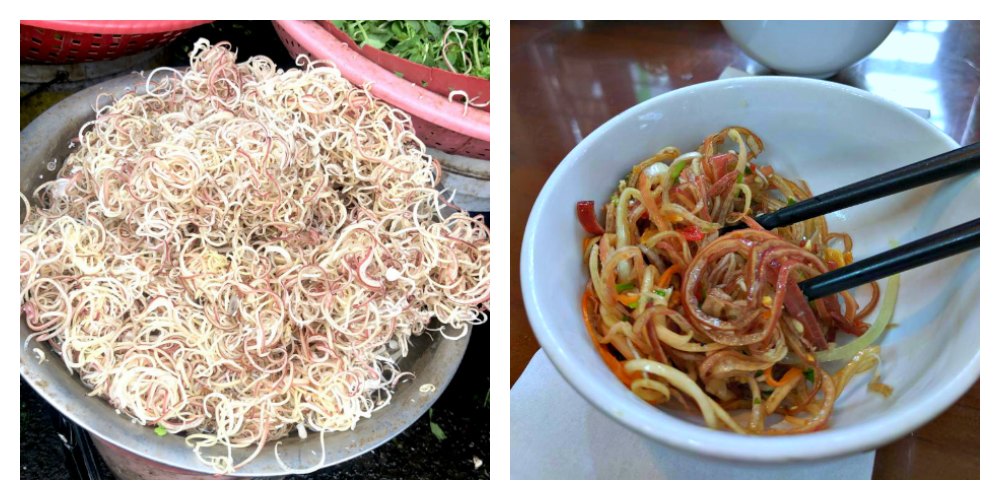
Banana Blossoms are everywhere in Vietnam and often are eaten as a side dish, with noodle recipes, and also in soups. Before they are used, the tough outer layer is removed and the blossoms are sliced into fine julienne strips and soaked in cold water and white vinegar or lemon juice to prevent them from browning.
The long colorful strips are then used as an ingredient in various dishes such as hot soup, noodle recipes and my favorite, the banana blossoms salad (“Nộm hoa chuối” or “Gỏi hoa chuối”). This is a great summer salad, the banana blossoms are soft, slightly crunchy and blends harmoniously with other ingredients all melded together in a complex lemon base garnished with crushed fried peanuts. It is a really delicious and light salad.
Banh mi Vietnam (Vietnamese Traditional Bread)
Banh mi is really popular eaten traditionally as breakfast, lunch or dinner and is the fast food, or food to go in Vietnam. The banh mi is made with wheat and rice flour and is used for sandwiches or just as a baguette with a meal. The sandwich includes a blend of savory items such as thinly sliced carrots, pickles, cucumbers, liver pâté, cilantro or Thai basil, special mayonnaise blend and a choice of different meats, egg or tofu and sprinkled with some soy or fish sauce. The bread is light and crunchy so when you bite into it expect the splinters to go everywhere. It is part of the joy of eating banh mi. Fortunately banh mi can be found outside of Vietnam
Green papaya salad with Beef Jerky- Nộm đu đủ bò khô or Gai Du Du
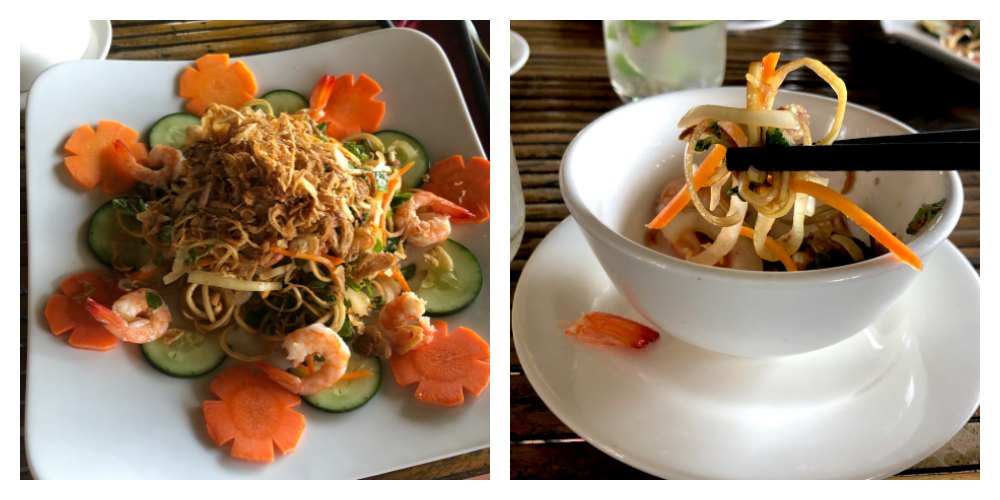
Vietnamese green papaya salad varies by region, northern will often be made with beef jerky and Thai basil (hung que). The southern variety with shrimp, pork and rau ram herb. The salad is made with one of two dressing options a fish sauce and lime dressing or soy sauce and vinegar. The green papaya is shredded and the juice squeezed out until dry so that when blended with the dressing, the dry papaya soaks up all of the flavors. I really liked the crunch of the salad, and the tangy flavors of the ingredients. My favorite was to eat it topped with shrimp.
Rolled rice pancake- Bánh cuốn

“bánh cuốn” is one of the members of the extended noodle family, It is a paper-thin steamed rice flour pancake. The pancakes are cooked on a linen steamer base, and then lifted off with chopsticks and immediately rolled with minced pork and mushrooms, and sprinkled with deep-fried shallots. The pancake is cut into bite sized pieces, and topped off with cilantro or Vietnamese basil. “bánh cuốn” was traditionally eaten as breakfast in Hanoi but now is also eaten as a late night snack.
Rice noodle soup-Phở
Pho (rice noodle soup) is a traditional soup in Hanoi. Pho is filled with warm yum, a flavorful bouillon, soft noodles, and sweet tender meat.
The broth is made with water, golden sautéed whole fresh onions, beef spare ribs or ox tail bones, cooked for an hour, and skimmed constantly to produce a clear broth. After the broth is strained, carrots, spices, salt, and fish sauce , thin sliced beef or chicken cooked rice noodles are added. You use both a spoon and chopsticks to enjoy this dish.
Bun Cha (Bún Chả)
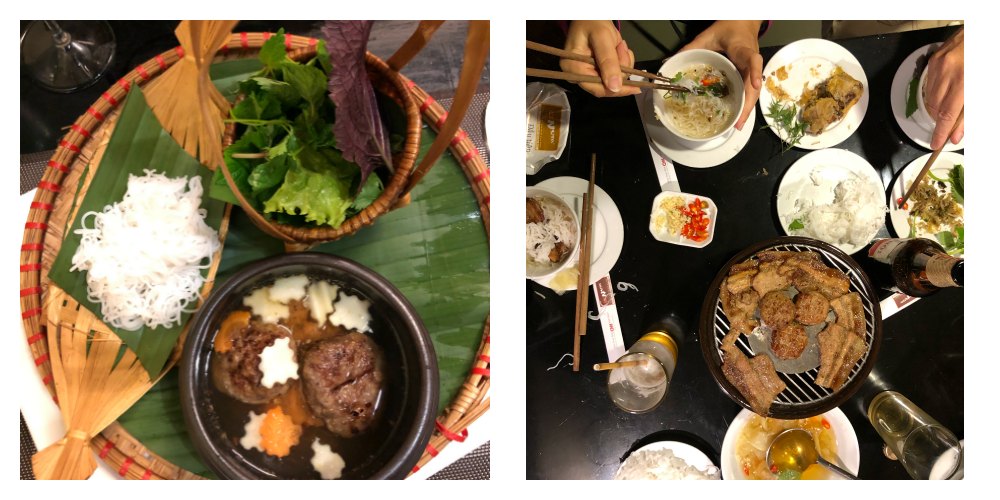
Bun Cha is a mid-day meal from Hanoi made of grilled pork and noodles. Bún chả is served with grilled fatty pork called Chả over a plate of white rice noodle bún and assorted herbs and broth. Once all is in front of you, the building of your meal begins. The ingredients can be mixed and match in many ways to include adding all your herbs into the broth and eat like soup or layer the ingredients into a bowl, or wrap them in a big leaf of lettuce and dip into the bowl of broth.
Banh Xeo (Bánh Xèo)

Banh Xeo or sizzling pancakes are from Central Vietnam. They are yellow crispy pancakes made of rice flour, water, and turmeric powder. They are a savory delight filled with a mix of ingredients including pork, shrimp, vegetables and herbs wrapped in rice paper and dipped in a special peanut sauce. One of my many favorite treats that I have searched out since returning home. I just can’t find them the same as they were in Vietnam.
The Journey Begins in Hanoi, Vietnam
Welcome to Hanoi! When I arrived, I felt I was definitely in a different place. I arrived late the night before and really didn’t get to see much of Hanoi travelling from the airport to the hotel. Waking up the next morning, I found myself alone, far from home, and ready to meet up with the tour group. It wasn’t long before I quickly connected with some of the travelers who had arrived a day or two earlier. We ate breakfast together and they ended up being my best travel buddies throughout the trip.
Traffic – A graceful Jazz melody

With breakfast out-of-the-way the next thing to do, and most important, was to acclimate to the traffic in Vietnam. The roads are a little like the wild, wild, wild west filled with motor scooters. There are few rules, even less traffic lights or signs and almost no pedestrian crosswalks. Crossing the street is literally a breath-taking event.
To understand the phenomenon of traffic in Vietnam, you have to understand that Hanoi is a city of 8 million people with 4.5 million motor scooters. Owning a car is an extreme luxury as they are very expensive. It was explained to me that car ownership is limited through taxation. If you buy a car made in Vietnam it is taxed at 150% of the price of the car. If the car is imported the tax is 300% of the price of the car. This is why Vietnam is a county of motor scooters; they are affordable.
Before the first attempt to cross the street, we spent some time sitting on the patio at the front of the hotel and studying it. The traffic was very entertaining. Motor scooters carrying a myriad of items, expertly packed, jostled through the traffic with the grace of a jazz song. There were delivery scooters with large boxes, giant bags of popcorn, cases of water, crates of eggs, bags of shoes, trees, anything you could think of all packed on to a single scooter. During the morning commutes, entire families would be crammed onto one scooter, to drop the kids at school and then the parents head off to work only to reverse the process in the evening.
It was time to take on our first challenge of crossing the street. The game plan was set, and through advice and observation, this was our successful recipe for crossing the street:
- Start by following a local. Walk close and stay with them, they understand why you are there.
- Once you step in the street, don’t stop your forward momentum.
- Maintain your speed during the entire crossing, don’t speed up or slow down.
- Look straight ahead, say a prayer and go.
Amazingly, the traffic will flow around you as you cross, the scooter drivers will gauge your speed and adjust theirs to go around you. There are so many motor scooters, and they all just sort of weave their way around each other and around the pedestrians and other obstacles on the road. If you stop during your journey across the road, you can gum up the whole works, at the least, or cause an accident, or worst case, get hit by a scooter. Be sure to go to Vietnam with plenty of good travel insurance.
Once you have braved a few crossings with a local, you start to do a few on your own, or with your group, and you get the rhythm down. I strongly suggest that you don’t ever let your guard down or walk with distraction.
Top things to do in Hanoi
Vietnamese Women’s Museum

The Vietnamese Women’s Museum explores the country’s cultural diversity and the significant contributions that women have made toward Vietnam’s development, of culture and society. In the museum you will learn about everything from marriage and birthing rituals, women and the war, to women in industry, and the fashions of the nation. It is a great starting place to learn about the culture where you will be spending the next few weeks. We don’t often have the opportunity or reason to learn the history of another culture until you travel. The Vietnamese Women’s Museum is a good place to start, as a little history and a good story get you curious about your upcoming journey.
Visit Hoan Kiem Lake (also known as Turtle Lake)

Prior to my arrival in Hanoi, two of my travel partners, Dee and Alex, visited Hoan Kiem Lake at night. They told me all about the evening activities and the beautiful Ngoc Son bridge that was all lit up.
Alex told me that, going their the first night in Hanoi, was fortuitous as it’s in a section of the city that is quiet and car free so having to navigate the traffic wasn’t a concern. Other than the initial street crossing to get there from the hotel. The Hoan Kiem Lake is an evening gathering place, with a variety of people, participating in a variety of activities. There were young school girls in matching outfits practicing a Zumba routine. Older couples were dancing the tango in a plaza with a crowd watching on. There were many teens in various groups who were dressed in punk clothes or a group in black clothing and they were all hanging out with their boombox and other groups of teens were jumping rope together. There were also many family groups that were strolling around the lake some with their dogs. The whole experience was a nice sampling of the leisure culture of Hanoi before hitting the busy hustle bustle of the city in subsequent days to come.
The other great feature of Hoan Kiem Lake is no traffic! Only pedestrian travel is allowed around the lake, so it is a nice respite from the busy streets. While there, be sure to cross the bright red-painted Huc Bridge or Rising Sun Bridge to Jade Island at the center of the lake, where you will find Ngoc Son temple. It only costs 20000 Vietnamese Dong (VDN), less than $1 USD, to visit the temple. If you arrive early in the morning, you can watch or join, the locals in their morning Yoga and Tai Chi. You can find Hoan Kiem Lake near the main post office near the old quarter. Ngoc Son Temple is open from 08:00 to 17:00 every day.
Visit the Temples!

They are everywhere! We stopped at the Temple of Literature located between Ton Duc Thang Street and Van Mieu Street which is about 2km west of Hoan Kiem Lake. Built in 1070 and dedicated to Confucius, it is a temple of learning rather than a religious temple. The Temple is a popular photo spot as it is filled with well-preserved traditional architecture.
Another temple we visited was outside of Hanoi, Tay Phuong Pagoda, located about 30km west of Hanoi center. Accessible by car, public bus, or motor scooter, it takes about 30 minutes to get there. The town below the temple was a woodcarving town utilizing Ironwood for carvings, furniture and the framework and design of the pagoda. And this is where I will say that I encountered my first “rustic toilet” experience in Vietnam.
Once there, we ascended a trail up from the town, that I found out was also a road, with motorbikes coming down as we walked up to the last few hundred stair-steps to the pagoda. At Tay Phuong we found many sculptures and art on display. The attraction at the Tay Phuong Pagoda is the detailed sculptures of monks rendered in lacquered jackfruit wood dating from the Tay Son period, just before the 1800s. This beautiful hilltop pagoda is an iconic architectural masterpiece of an ancient civilization of people in Doai region wood-framing, and curved roofs tops covered in tiles.

Tay Phuong Pagoda was my first of many temple visits while in Vietnam, and it was so beautiful and peaceful. It was one of those places where everything was perfectly composed for a photo. I was fascinated with the burning incense that are lit by worshippers. The thin streams of scented smoke twisting into the air all around add to the feeling of serenity and thoughtfulness, and variety of shoes waiting on door mats for their feet to return.
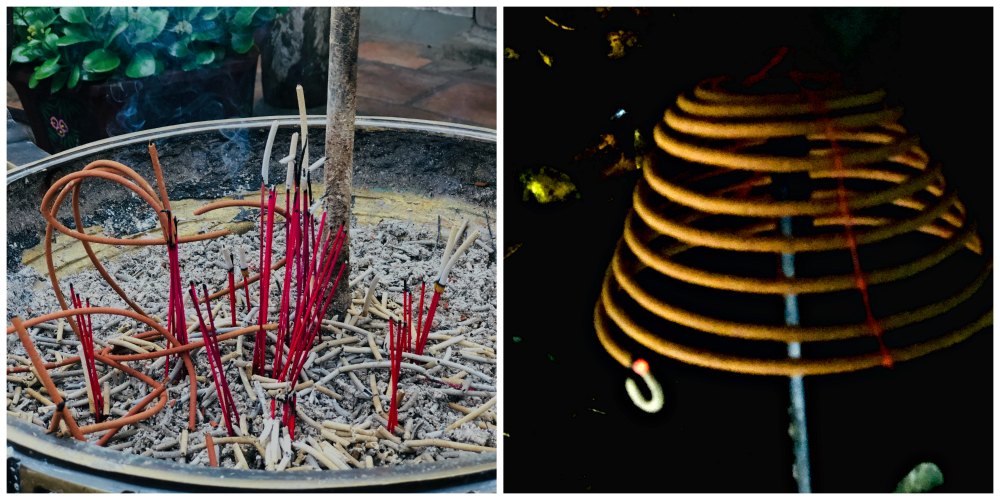
Old Quarter Cyclo-Ride, ‘Xich Lo’,
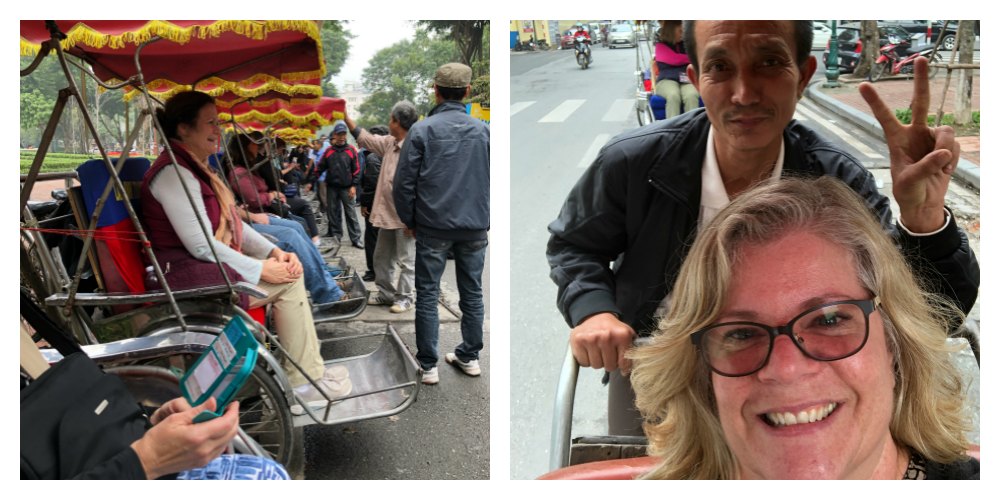
Visiting the Old Quarter of Hanoi is a buzz to your senses. You can of course walk through the Old Quarter or try a Cyclo-ride, ‘Xich Lo’. It is a green form of transportation that used to be a popular way to get around town. In the 1990’s motor scooters took over the streets and Xich Lo rides were corralled into the tourist areas and off the busy routes of transportation. Today, the Xich Lo rides are catering to tourists in tourist areas only and many if not all of the drivers are Veterans of the American War (known as the Vietnam War to Americans).
Taking a Xich Lo tour is a great way to safely get around the old quarter and see a lot of things in a short period of time. You will have the thrill of zooming along at street level as your driver races other drivers along the busy streets. It is so much safer than walking along the streets as you are in the hands of an experienced driver. You can ask your driver to stop while you check out the shops and you’ll also get some history lessons as you tour. Be sure to negotiate the price of your ride before you get in the seat. A fair price for a tour through the Old Quarter would be around 150 000 VND, $7.00 USD.
Come on a quick ride with me:
The only down side of the Xich Lo tour is the exhaust, so if you’re sensitive, be sure to wear a face mask.
Hanoi Hilton, “Hoa lo Prisin”
I was experiencing mixed feelings about our visit to the Hanoi Hilton, “Hoa lo Prisin”. I wasn’t sure how I felt about the visit as the stories I have heard about how prisoners of war were treated gave me an uneasy feeling. It decided to go because it is a part of history and the story of Vietnam. The Hoa lo Prisin was originally a political prison during the time of the French occupation of Vietnam. It was later used by North Vietnam for U.S. prisoners of the Vietnam War, “American War,” when it was nicknamed, The Hanoi Hilton. The prison itself no longer exists, but the gatehouse is still intact and used as the museum. I was struck by how centrally located the prison was. It sat right in the middle of Hanoi, like any other building you would walk in to. The Government curated tour of the prison was very sanitized and geared toward the French occupation era rather than the Vietnam War era. I wonder if there are more than one type of tour depending on your country of origin.
Get a Massage, or Several!

One of my goals while in Vietnam was to have as many massages as possible. Start by asking at your hotel for a recommendation on where to go to find a reputable massage place. I had two recommendations to follow-up on, one from the hotel and one from the tour guide. We checked out both and opted for the least expensive of the two. For about 130,00 VN ($7.00) you can have an hour-long massage. You can choose between a full body or a foot massage. The foot massage included your head, neck, shoulders, arms, legs and of course foot reflexology.
In our group, two of us chose the foot massage, while the other three disappeared in the back for full body massages. This is where we discovered it was worth it to pay a little more for your massage. The massage was fine, but the environment was a little unsteady. For those of us that chose the foot massage, we sat on some velour lazy-boy type couches that smelled a bit like mildew. A plastic lined pail of brown water was slid in front of us to soak our feet in. We were assured the water was seeped in some healing herbs or something, to me it was just a bit brown.
The other three in our group were set up in a couple of communal massage rooms. One room had massage tables, and another room sported another dark velour lazy-boy type couch. There were also other people in your room with you, male and female, and you have to navigate your way onto the massage table in whatever fashion of modesty you are accustomed to. I heard that there were some awkward moments during the full body massages.
When you have your first massage don’t be surprised as a Vietnamese massage involves your masseuse climbing onto your back and massaging you with their legs, and elbows and maybe feet? If you aren’t expecting it, it is quite a shock as they climb on your back. Overall, the massages were great, it was the environment that takes some getting used to. I suggest paying a little extra for a little more luxury and privacy.
Water Puppet Show

Water puppetry, Múa rối nước, lit, which means “Making puppets dance on water”. A tradition from the 11th century that originated in North Vietnam. The puppets are made of lacquered wood and performances are in a small pool with the puppeteer standing in waist-deep water and controlling the puppets with long rods under the water, made of bamboo. The puppeteer is behind a screen moving the rods giving the appearance that the puppets are moving and dancing on the water as they tell a story. We had the opportunity to visit the home and studio of the family that has made and performed water puppetry for seven generations. We were able to visit their studio for a puppet show and shop in the wood shop to pick out a puppet to take home. It was a unique experience and opportunity to meet the family, ask questions and learn about the ancient art of Múa rối nước.
Hanoi was a whirlwind for all the senses of which I enjoyed taste the most. There is so much to see and do there, I am sure that we only chipped the tip of the opportunities. But our next adventure would take us to northeast Vietnam, where we spend 3 days cruising on Ha Long Bay. Check back for details on the journey through Ha Long Bay.




4 Responses to “Food Travels – Vietnam”
Sue Gaden
Outstanding details which triggered many memories. Congratulations on a job well done!
Nancy
Thanks Sue!
Stacey
Sounds like an amazing trip. It also sounds similar to my visit to Malaysia. Especially the masseuse jumping on my back. I was like “HELLO!” LOL
Nancy
Stacey,
Right? Those massages are quite the experience!